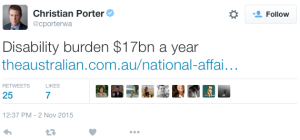
Last week The Australian published an article under the headline “Disability a $17 Billion Burden”. The article itself is not completely problematic – it even points out that a “detailed study last year showed that much of the growth in the DSP had come from the ageing of the population, an increase in the retirement age for women and a major shift in other income support programs.” So I’m glad to hear that despite the offensive title, The Australian isn’t perpetuating our national conversation where disability payments are the first on the chopping block, while also being the first to be listed as underfunded social services. The assumption that because “this costs a lot it must be a burden on us, it must be something that is wrong”.
What is problematic is the blatant classification of people with disabilities as not only failing to contributing to society, but actively being of detriment to it. Even worse than that headline is the fact that the Minister for Social Services, Christian Porter, used this same phrase.

The comments on the article are really where you see the problem with the headline and its encouragement of already rampant societal ableism. Some of them are pretty general dismissiveness.
“Everyone is vulnerable including tax payers asked to work harder for longer to pay for an ever increasing numbers of malingerers” – Rob.
“Time to become more self sufficient, get on with it and stop whining” – Raymond.
Some of them are downright confusing attempts to rank suffering.
“People who are born with disability’s are being forced to compete with once able bodied persons” – Rodney.

“If you’ve got better than 50% function in all your limbs and an IQ over 75 you’re not disabled. Everything else is garbage and an invitation to malinger” – Jason.
I’m not quite sure why having a relatively normal childhood makes my current inability to do something as simple as go to the shops less valid.
I also don’t know exactly how to quantify 50% limb function, but then, I am neither a medical professional nor a legislator. In fact, I am so unaware of what is normal for the human body that I turned twenty before I learned that walking to the local shops doesn’t make most people hurt and feel like they are about to vomit and/or faint. I also thought that there was nothing wrong that a pressure bandage wouldn’t fix when I played volleyball with a recurrent partially dislocated wrist for three years. The internalised ableism of ‘just get on with it’ is pretty strong, so it’s probably not always safe to assume people are lazy and melodramatic.
If you want more quantifiable categories, the government is actually a lot more specific than 50% limb function. There is a very interesting piece of legislation that details exactly what you have to not be able to do in order to be considered sufficiently impaired. There are four categories of functional impairment: mild, moderate, severe, and extreme. The part that I find most interesting about this form of assessment is that you can have a moderate functional impairment in all fifteen categories without qualifying for the DSP. An example of a moderate impact? “The person is unable to sustain work activity or other tasks for more than 2 hours without a break due to symptoms”. Can you imagine multiplying that level of everyday difficulty by fifteen different categories, and then being told that you’re a malingerer and ineligible?
There’s also this gem of a comment, by someone who clearly has literally no idea of how the Disability Support Pension is assessed:

“It all began when Keating did away with the impartial Commonwealth Medical Officers of Health who adjudicated at arms length on applicants claiming a Disability Pension. Now it’s decided by non medical office dwellers at Centrelink who at first gave everyone a pension to get them off the Unemployment figures and make the Federal Government look good” – Gej.
In case you are curious, there are a lot of requirements to hurdle before you get anywhere near that pension. You don’t just need to provide evidence your condition is “fully diagnosed, treated, and stabilised”, and that you will not be able to work more than 15 hours per week in the next 2 years. You will also need to attend a Disability Medical Assessment with a government selected medical professional, and a Job Capacity Assessment with another government official. If you are under 35, you’ll also have to attend regular participation interviews (because under-35s are intrinsically less trust worthy).
As with all funding for disability, you’ll also have to wait a while. The Centrelink staff I talked to about getting help with medical expenses were incredibly helpful in going through the different options that I should apply for in the mean time, because the DSP application will take a while.

Similarly to the Queensland Disability Services funding where you phone up, receive a call back in about a week, after which they will take a few days to send you forms. Once you have those forms and fill them out, you can expect to wait a few weeks until you hear back from them about whether you qualify for an independent assessment. All up you’re looking at a 3-4 month wait to find out whether you’re eligible for mobility aid funding. Funding that you are not allowed to apply retrospectively to any aids that you might have purchased in that time. Like, say, the wheelchair you might need in order to go shopping.
So maybe instead of talking about how people are malingerers, you should consider the fact that approximately 20% of Australians have a disability, and an additional 20% have a long term health condition. Despite that, just under 5.5% of Australians receive a Disability Support Pension, just under 25% of who are over the age of 60.
One last thing – on average in OECD countries, 22% of households containing a person receiving disability benefits live in poverty. That gap is significantly higher in five countries: Australia, the UK, the USA, Ireland, and South Korea. That doesn’t sound like the easy life.
